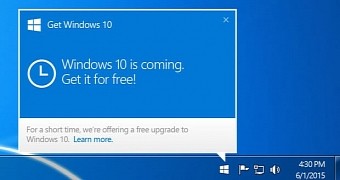Yesterday we reported that KB3035583 has been re-enabled on a number of Windows 7 PCs in order to force the Windows 10 upgrade and it turns out that another patch is responsible for all of this.
Basically, Microsoft has rolled out another update that enables KB3035583, which in its turn activates the Get Windows 10 app and displays upgrade nags on Windows 7 and 8.1 computers.
The update in question is KB3150513 and is aimed at both Windows 7 and 8.1. Its purpose is to prepare computers running any of these two OS versions for the upgrade to Windows 10, but in order to do that, it has to un-hide the original KB3035583 patch that Microsoft uses for upgrade distribution.
The description that Microsoft offers in the KB page doesn’t include too many details, though:
“This update provides updated configuration and definitions for compatibility diagnostics performed on the system. The updated definitions will improve accuracy and help enable Microsoft and its partners ensure compatibility for customers who want to install the latest Windows operating system. This update will be offered only if KB2977759, KB2952664, or KB2976978 is installed on Windows 8.1, Windows 8, Windows 7 Service Pack 1 (SP1), or Windows 7 RTM.”
Compatibility issues scanner
What’s more important than a sketchy description, however, is that this new update is offered as recommended, so it’s automatically checked in Windows Update for all computers configured to receive new patches from Microsoft. This means that Windows 10 upgrade nags could actually show up once again on pretty much every PC getting automatic updates.
It appears that KB3150513 makes modifications to AppRaiser, the Get Windows 10 app feature that checks for compatibilities on a Windows computer before the upgrade to Windows 10. This way, users can find out what apps are fully compatible with Windows 10 and which are going to be removed once the setup begins, letting them decide whether to initiate the upgrade immediately or delay it until compatibility issues are resolved.
For the moment, if you still don’t plan to upgrade to Windows 10, hiding both KB3150513 and KB3035583 seems to be quite a good idea. Keep in mind that the Windows 10 upgrade offer ends on July 29, so you should make a decision very fast.

 14 DAY TRIAL //
14 DAY TRIAL //